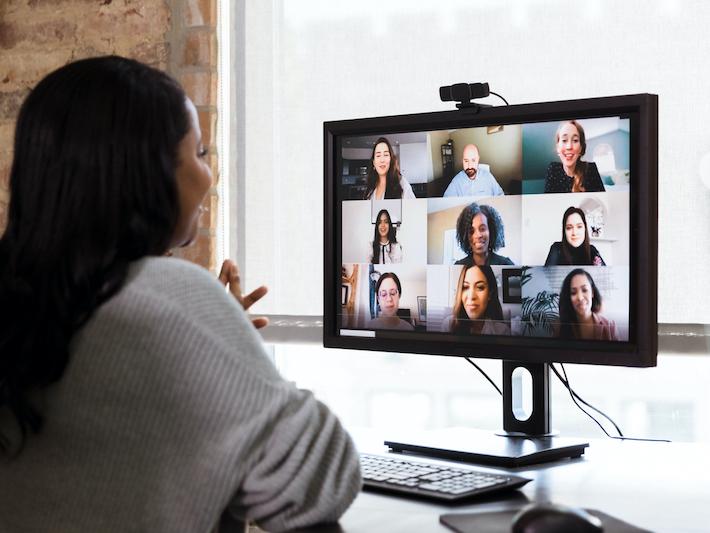With online and hybrid teaching now much more common, many university educators have experienced the dread of teaching an online class filled with dark screens – a true dystopian setting where we do not see our students. In such cases, we cannot rely on the usual signs to indicate whether they are following the content and understand the information we are sharing. We cannot see whether students are paying attention, if they are in front of the computer, or even in the same room as the computer. These past three years, I have noted certain strategies that can help student engagement and, as a result, encourage students to turn on their cameras. The following steps resulted in all my students’ cameras being switched on in classes of 50 students at Xi’an Jiaotong-Liverpool University, and previously at York University in Toronto, Canada:
Before you start the course
Explain the importance of face-to-face interaction in a community: In the first class, be explicit that to make this course more like in-person teaching, or a “real” classroom, everyone needs to make a joint effort to turn on cameras during lectures and seminars. This way, students get to know each other, I get to know them, and everyone feels more comfortable participating and asking questions. Many students explained that they previously hesitated in raising their hands and participating in courses because dark screens were intimidating. Once you see everyone’s faces and smiles, it is easier to share and debate ideas in a safe environment.
- Stay in the frame: how to persuade students to keep cameras on in lessons
- To see or not to see: managing the complex issue of Zoom cameras
- The basics of building engagement and motivation for learning online
Highlight the role of online face-to-face for high-quality learning: Explain how helpful it is to see students to ensure that everyone is following the content. Tell them how when you give lectures, you look at students and can identify if they don’t seem to understand a concept, enabling you to stop and clarify it further, perhaps by providing relevant examples and case studies. You can more easily learn students’ names and get to know them, which helps you track individuals’ progress throughout a semester. It helps you to link students’ comments from previous lectures to what they are saying today as well as to other student contributions.
Be friendly: For students to feel comfortable showing their faces on camera, they must trust their teacher. At the start, introduce yourself, share your story and talk about your research and previous work experience. Make it very clear to students that the fact that they turn on their cameras does not mean you will ask them tricky questions and put them on the spot. On the contrary, underscore that you will ask questions and all students are free to raise their hands when they wish.
Allow for flexibility: Some students may not feel comfortable showing their homes, which they may share with parents, siblings or room-mates. Explain that they are free to have any background on the screen behind them: a landscape of their choice, a character, a picture. One of my students chose a scene from his favourite Chinese war movie. This personalisation can aid conversations when the class is getting to know each other. Some students may be shy: some only showed their eyes, and then progressively the whole face as they became more comfortable.
The benefits of turning cameras on
Experiential education: Students’ active participation in a virtual leaning environment – giving presentations in class and asking and answering questions with their cameras on – is excellent practice for future professional experience. Whether students plan to present papers at conferences, attend online meetings or even create podcasts, with practice they will become more comfortable and confident speaking to a crowd of people via a screen. I have noticed big benefits from this pedagogical approach: students tend to engage more with reading and course material, develop communication skills and perform better when giving class presentations. When classes resumed hybrid teaching with some students in the classroom, others online, some students in the classroom came to the front of the class, closer to the camera, to answer and ask questions so their fellow classmates online could see and hear them well – an exercise that certainly requires confidence in front of 50 students.
Students’ improved sense of belonging: These past three years, many students had internship opportunities and extracurricular activities postponed; many were confined to their homes and felt invisible. Encouraging them to turn on their cameras and be seen, as well as see fellow classmates, enabled them to develop friendships and a sense of belonging, as demonstrated by outstanding teamwork in class presentations and study groups. They felt like fully fledged participants, valued members of a teaching group, and noted in their student evaluations that “everyone was involved and it was a collaborative learning experience”.
Clara Chapdelaine-Feliciati is associate professor at Xi’an Jiaotong-Liverpool University and a lawyer with the Law Society of Upper Canada.
If you found this interesting and want advice and insight from academics and university staff delivered direct to your inbox each week, sign up for the THE Campus newsletter.




comment